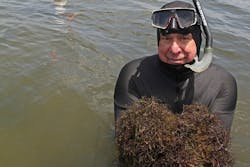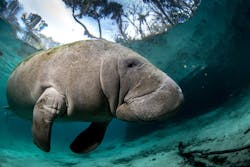Booms & Blooms
Brian E. Lapointe, Ph.D., is research professor for Florida Atlantic University’s Harbor Branch Oceanographic Institute. Lapointe can be reached at [email protected].
Editor’s Note: The opinions expressed in this op-ed represent those of the individual author and, not necessarily those of Florida Atlantic University.
undefinedFlorida is booming. Unemployment is down, real estate values are up and the population is growing … fast. There are now 21 million Floridians. Since 2010, the Sunshine State’s population has jumped by 11.6%, more than twice the national average of 5.5%.
Growth often brings prosperity, and Florida’s economy is strong. But growth also can create problems. Many formerly small, rural communities have exploded in size, especially those along lakes, rivers, estuaries and coasts. For some of them, rapid growth did not allow for proper infrastructure development—specifically wastewater collection and treatment. Today, there are too many homes relying on septic tanks, which is a big problem for the state’s valuable and fragile aquatic ecosystems.
Septic tank systems have been used successfully in Florida for many decades. They require sufficient acreage for use as a drain field where pollutants are naturally diluted by percolation through aerobic, dry soils. It is a natural and effective treatment system, except when there are too many septic tanks in close proximity.
In high-density neighborhoods, there is not enough land space for septic tanks to properly filter the sewage. The untreated sewage, containing nutrients and fecal matter, seeps into the groundwater and then makes its way into nearby canals, lakes, estuaries, rivers and even the ocean. (See Saving Coral Reefs on left)
Scientists have been able to trace man-made compounds such as nitrogen isotopes, sucralose (artificial sweetener) and acetaminophen from neighborhoods to recreational waters. The over-abundance of nutrients in these compounds, combined with Florida sunshine, causes harmful algal blooms.
Seaweed is one common type of macroalgae. It blooms on the bottoms of springs and shallow coastal waters, smothering natural seagrasses, sponges and coral. Other types of macroalgae float and bloom on the water surface, cutting off sunlight and impeding wildlife, anglers and boaters.
Microscopic algae called phytoplankton can eventually become so dense that they reduce the sunlight penetrating the water. This leads to water discoloration (red, green or brown, depending on the type of algae) and further loss of corals and seagrasses. Without corals and seagrasses and their associated biodiversity, the fish and larger marine life either move away or die off.
Some species of macroalgae and phytoplankton can produce toxins—potential threats to wildlife and humans. Bacteria from decaying algae consumes oxygen, creating “dead zones” that are unhealthy for fish.
In Florida, algae has become an economic issue as well as an environmental concern. Waters become polluted and marine habitat is lost. Real estate values decline as residents and tourists move elsewhere. Sport anglers and professional fishermen can only watch as game fish die off. Businesses suffer and jobs vanish. Unless Floridians recognize the significance of the problem and act soon, much of what makes the state beautiful and unique will be lost, perhaps forever.
Algae Initiatives
Sarasota County public works officials began to study septic system pollution in the mid-1980s. Research revealed that fecal coliform pollution had reached a level that made a local creek unsafe for humans and unhealthy for aquatic life. Likewise for Charlotte County in southwest Florida, high levels of nitrogen were endangering marine life. Crystal River, famous for its manatees, was cited for nitrogen impairment in the early 2000s, where algae blooms in the Indian River Lagoon were linked to massive seagrass die-off and the deaths of hundreds of manatees and pelicans, as well as dozens of bottlenose dolphins. (See “Nitrogen Reduction Helps Restore Manatees’ Habitat” above.)
Research revealed that septic tanks were a significant part of the problem in all these communities. Rapid population growth had occurred without sewer collection and treatment systems in place. Septic tank systems, as well as storm water runoff from agricultural and urban areas, overloaded the nearby bodies of water with nitrogen, phosphorus and other pollutants.
All these communities responded by installing modern central sewage collection systems and treatment facilities. In each case, the local waters began to improve. However, while each of these communities is turning the tide against groundwater pollution, other cities and counties are only now addressing the septic tank issue.
A clean environment and healthy wildlife are essential to Florida’s economic future. More than 100 million visitors come to the state each year to enjoy the sun and water, but if the water is polluted, the tourists and snowbirds will go elsewhere and the economy will suffer. As Tampa Bay Estuary Program Director Holly Greening recently stated, “helping the environment is not in opposition to helping the economy.”
In fact, they are directly connected.
Awareness & Inertia
For Florida, awareness and inertia are challenges. Every homeowner with a septic tank should be aware that their
sewage may be contributing to the algae onslaught that is damaging the water and wildlife. Likewise, they also must be motivated to act. Many people choose to be idle on environmental issues unless they are directly affected.
Local politicians must be informed, as well. They need to seek the advice of scientists regarding the impact of algae on their local environment and speak to civil engineers about the best solutions to transition from septic systems to modern sewage collection and treatment. Making these changes takes time, so the time to start is now, before the damage is irreparable.
Florida communities such as Charlotte County, Crystal River, Sarasota County and others have proven that modern sewer collection and treatment will reverse the negative impacts of sewage pollution in the environment. Now other cities and counties must step up and take the initiative. The fight against algae is the fight for Florida’s future.
Saving Coral Reefs
By Stephen Frink, Author & Professional Underwater Photographer
I live in Port Largo, Fla., a subdivision of Key Largo, which has very deep and wide canals. I noticed an almost immediate difference in water clarity within six months of the completion of the Airvac vacuum sewer system in 2011.
This was not surprising, because I was aware of septic-tank tests in which colored dye was flushed into the system and, within an hour, could be seen percolating out through the bedrock and into the canals. Switching from septic tanks to a modern sewer system made an obvious and almost immediate impact on the local marine environment.
I came to Key Largo in 1978 and saw a steady degradation of the coral reef, to the point where I thought it would never come back. Now, I feel optimistic. There are other challenges to creating a healthy marine environment, like ocean acidification and coral bleaching from global warming, but important things can be done to promote cleaner, healthier waters. It is cliché, but we have to think globally and act locally. We can start by making wise decisions about our wastewater infrastructure.
My work takes me around the world, so I do not often dive in my home waters. I dive Key Largo episodically, but that is good, because if you see conditions infrequently, you notice the changes. I definitely have noticed a positive change in the waters around Key Largo.
Nitrogen Reduction Helps Restore Manatees’ Habitat
By David Burnell, Crystal River City Manager
Crystal River is the self-proclaimed “home of the manatees.” We’re located on Kings Bay, which is connected to the Gulf of Mexico by the Crystal River. Each year, several hundred manatees migrate to Kings Bay for the winter. The manatees are a claim to fame, an important tourist attraction, and a vital component of the local economy.
A little more than a decade ago, we discovered that Kings Bay was becoming nitrogen impaired. The abundance of nitrogen in the water was causing abnormal algae blooms. The algae would float for a few days, then settle to the bottom of the bay and form a fibrous mat that prevented the growth of the vegetation that manatees eat. As a result, the manatees began to die or seek other, more hospitable habitats.
Most of the nitrogen in Kings Bay was entering the environment from septic tanks, which leached sewage into the local groundwater and canals. The nitrogen-rich water and sunshine resulted in rapid algae growth. To eliminate the excess nitrogen, we had to eliminate the excess sewage entering the environment.
One of our best ideas was to install a vacuum sewer system by Airvac to replace approximately 600 septic tank systems. Vacuum sewers do not leak. The collection lines maintain constant vacuum pressure, so there is no infiltration or exfiltration; no sewage escapes into the environment, and no groundwater enters the collection system.
Today, Kings Bay is on the mend. Nitrogen levels are way down and manatees are returning to the area. For Crystal River, a healthy environment means a healthy economy.
Less Disruptive, More Cost Effective
By Dan Saus, City Manager, Marathon, Fla.
About 20 years ago we discovered trouble in paradise. The waterways, shorelines and coral reefs were suffering from nutrification, an excess of nutrients usually caused by sewage and agriculture runoff. This created an abundance of algae that threatened our natural resources and aquatic wildlife.
To reduce the number of septic tanks in the area, we installed Airvac vacuum sewer systems in several local municipalities. The number of septic tanks in relative close proximity were leaching sewage into groundwater and canals. Replacing them with a leakproof central sewer system greatly reduced the nutrification problem.
The city of Marathon, Fla. selected vacuum sewer technology for several reasons. The Keys are built primarily on coral rock and we have a high water table, which makes excavating and installing collection lines difficult. Vacuum sewers can be buried at much shallower depths than gravity sewers. The installation requires smaller equipment, is less disruptive, and faster than gravity sewer installation would have been. This is a significant advantage in our developed neighborhoods.
Furthermore, vacuum sewers are closed systems; there is no infiltration of groundwater or exfiltration of sewage, so it prevents sewage pollution. The vacuum stations also require less energy than gravity pumping stations. The stations, which are designed to resemble the neighborhood architecture, are odorless and can be equipped with backup generators, so we do not lose sewer service during a power outage, even after hurricanes.
Vacuum sewers were an effective and efficient choice to replace the septic tanks that were pervasive in this area. Eliminating sewage pollution has helped our waterways and reefs become healthy again, and the natural beauty of the Florida Keys has been preserved.

